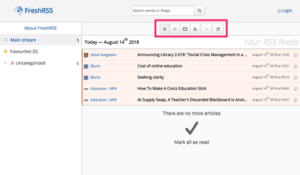I thought I would explain how Cindy and I came to write several textbooks for the higher education market. In my experience with publishing companies, our experience was unique and makes a story worth telling.
Most college profs who end up writing a textbook get their start in a specific way. The larger textbook companies have field reps who pitch textbooks to profs. We get free books and supporting tools and content (e.g., videos for class, question banks, ideas for class) to encourage the commitment of the students in our classes to an adoption. The money in the adoption is mostly in the first use. After that, used books take over and the companies make little money. This is why reps work hard to encourage new adoptions.
One of the other things these reps do is scout for new talent. Asking “have you considered writing a book” is a great way to play to the ego of the folks they are trying to get to commit to their existing books and getting profs to write a sample chapter or two and propose an outline and ideas for a new approach do result in a few new opportunities. Most who end up writing a book have also done some previous work for these companies. They may have been reviewing chapters from another book and offering related ideas or authoring the supplemental materials that accompany an existing book. Faculty members work really cheap, but we also know this is the way companies scout for talent. As an author of a book being edited, you can see this is the reviews written to offer you suggestions. Reviewers work hard to impress companies with their writing skill and knowledge.
Our book opportunities did not involve these traditional mechanisms. Our opportunities originated with coloring books. Cindy was working with teachers to find productive ways to engage students with technology when teaching traditional content and skills. Strange as it may seem today, her ideas and mine were not traditional. At the time, she was working with a program called Kid Pix and I happened to be heavily involved in creating study tools for college students using a Mac program called HyperCard. One of the tools available for the Mac was called ResEdit. This tool allowed the resources embedded in a Kid Pix file to be isolated, copied and pasted. When kids used Kid Pics they could use several Kid Pics tools to create drawings, import and modify images, and to add sound and eventually save the combination out as a single file. ResEdit allowed the image and sound to be copied from this file and added to a HyperCard stack. What we did with this capability was to create self-playing slide shows. There are so many ways to do this now, but our approach was original at the time. A typical strategy was to have individual students or student pairs create a Kid Pix file on a specific instance of a more general topic and then combine these individual creations into a slideshow on the topic. Apple showed our projects for years before companies figured out how to mimic this technique in an easier way (e.g., Kid Pix Companion).
Our interest in this technique led us to search for topics and materials that would be conducive to such an approach. Cindy and I were attending a conference in Chicago and were browsing a large bookstore during this trip. We came across a section that offered many thematic coloring books. You have probably encountered these coloring books without giving them much thought – e.g., Presidents of the United States, mammals, butterflies. You may know the expression – “discovery favors the prepared mind”. We immediately recognized a source for the projects we had in mind. I had a related idea. I wanted to digitize these coloring books and write a short “how to do it” manual a company could use to sell the combination as a product. I looked inside a coloring book from the giant collection in front of me and found that the coloring book was copyrighted by Houghton Mifflin.
I wrote up a proposal for Houghton Mifflin explaining the idea and describing some of our existing projects and techniques and sent it off. In a few weeks, the rejection letter came explaining that the division responsible for the coloring books did not do that kind of thing. End of dream? It turned out it was not the end. Weeks later we are notified by Houghton Mifflin and told that the education editor had heard about our proposal and would like to fly to Grand Forks, North Dakota, to visit us and see what we are doing. It is hard to explain just how unusual this situation was. This simply just does not happen.
Loretta Wolozin flew to Grand Forks from Houghton Mifflin headquarters in Boston and we showed her how we and the teachers we worked with did what we did. We owe much of what we eventually achieved to the early projects created by Pam Carlson and her second-grade students. The butterfly project resulting from what these students learned about butterflies, the life cycle of butterflies, and the butterflies of the United States by rearing monarchs and exploring books about butterflies were expressed as colored images of butterflies plus range maps, a song about butterflies, and other content available to all as a HyperCard slide show. It made an impressive demonstration.
Loretta offered us a contract to write a textbook for preservice educators wanting to learn what their students might do with technology. The offer required that we could expand the scope of the core ideas in our original coloring book proposal. Cindy and I came up with a concept we called “Technology Integration” to describe the most unique concept in our approach. I got the idea from a book by David Jonassen called “Mind Tools” which was about using technology productivity tools (word processing, databases, spreadsheets) as a way to explore the concepts and skills taught across the curriculum. The idea was to get beyond teaching the tools as computer literacy to using the tools in authentic ways to learn. We added our project approach, broadened the list of productivity tools available, offered a cognitive model of learning to explain the value of these activities, and explained related issues (cooperative learning, issues in the responsible use of technology). A book explaining how technology could be integrated in all classrooms was born.
Eventually, other opportunities followed. We had some success writing grants related to our ideas. We wrote a book extending integration themes to Internet activities (first as a separate book and later as content integrated into the original book). I develop content on technology integration to be included in textbooks for other college classes written by other authors.
Houghton Mifflin never did take advantage of our original suggestion, BUT I found another organization that would. My original career goal was to become a high school biology teacher. This was before I became interested in educational psychology. I did get an undergrad degree in biology and went through the teacher education program to become a biology teacher. My writing often contains references to this content and issues in teaching this content. My interests in technology and biology resulted in my collaboration with the Game and Fish Department in North Dakota. This state government department is called the Department of Natural Resources (DNR) in most states. These organizations are mainly interested in hunting and fishing, but also usually promote interest and education in natural resources including the development of resources provided to schools. I found a niche related to this mission.
One of the ideas I promoted was the digitized coloring book project. Game and Fish had a simple coloring book mixing some North Dakota wildlife into a very coloring book. They were willing to commit to the development and distribution of a more complete and thematic collection of images of mammals, reptiles, birds, etc. This content was originally distributed as hypercard stacks, but eventually moved online as a component of other resources we offered through a server I managed for the department.
I still have these images on my server. They look primitive now and are less useful than the images available to teachers through services such as the Noun Project. My images are bitmapped and cannot be manipulated into different sizes as easily as images in a PNG or SVG file format (https://thenounproject.com/). However, the Game and Fish “coloring book” images still exist and are available (http://learningaloud.com/clipart/).
Yes, this is the kind of story an old guy tells. However, it is kind of story that also leaves you searching for the next great adventure.
![]()



You must be logged in to post a comment.